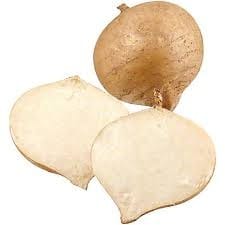Table of Contents
Jicama: A Comprehensive Guide to Varieties, Cultivation,
Introduction
Jicama (Pachyrhizus erosus), also known as Mexican yam bean or singkamas, is a crunchy, sweet root vegetable native to Central America. Revered for its juicy texture and versatility, it thrives in tropical climates and is a staple in Latin American and Asian cuisines. This article explores its global varieties, cultivation practices, health benefits, and culinary applications.
Global Varieties & Colors

Jicama is primarily categorized by size and regional cultivation:
- Pachyrhizus erosus: Common jicama with light brown, papery skin and crisp white flesh.
- Pachyrhizus tuberosus: Larger, less common variety found in the Amazon.
- Asian Jicama: Smaller, sweeter roots popular in Southeast Asian dishes like popiah (spring rolls).
Colors:
- Skin: Tan or brown.
- Flesh: Bright white, occasionally with a yellowish tinge.
Sensory Profile
- Smell: Mildly earthy and slightly sweet, reminiscent of fresh apples.
- Flavor: Crisp, juicy, and subtly sweet with nutty undertones.
- Texture: Crunchy like water chestnuts or raw potatoes.
Nutrition & Health Benefits
- Calories: 38 kcal per 100g.
- Rich in: Fiber (4.9g), Vitamin C (34% DV), Potassium (4% DV), and prebiotic inulin.
- Glycemic Index (GI): ~35 (low), ideal for blood sugar management.
Health Benefits:
- Gut Health: Inulin promotes beneficial gut bacteria.
- Immune Support: Vitamin C boosts immunity and collagen production.
- Weight Management: Low-calorie, high-fiber content aids satiety.
- Heart Health: Potassium helps regulate blood pressure.
Cultivation & Major Producers
- Climate: Tropical or subtropical (25–30°C/77–86°F); frost-sensitive.
- Soil: Sandy, well-drained soil with pH 5.5–6.5. Requires 6–9 months to mature.
- Top Producers (2023):
- Mexico (largest producer and exporter).
- Ecuador and Costa Rica (Central American staples).
- Philippines and Thailand (key Asian growers).
- Exporters: Mexico, Thailand, China.
- Importers: USA, Canada, Japan, EU nations.
Diseases & Pests:
- Root Rot: Caused by waterlogged soil; ensure proper drainage.
- Bean Beetles: Target leaves; use neem oil or organic pesticides.
- Powdery Mildew: Treat with sulfur-based fungicides.
⚠️ Safety Note: Jicama leaves and seeds contain toxic rotenone—only the root is edible.
Home Farming & ROI
- Planting: Sow seeds or tubers in warm climates. Space vines 8–12 inches apart; provide trellises for support.
- Harvest: Dig tubers after 6–9 months when leaves yellow.
- ROI: Moderate. A 10x10 ft plot yields ~15–20 lbs; farmers' market prices average $2–4/lb. Profitable in niche markets due to rising demand for exotic produce.
Culinary Uses & Storage
- Raw: Julienned in salads, slaws, or dipped in chili-lime salt (Mexican tajín).
- Cooking Methods:
- Stir-Fries: Adds crunch to Asian dishes (e.g., pad Thai).
- Soups/Stews: Simmer in broths (common in Filipino sinigang).
- Baked: Jicama fries (toss with olive oil, paprika, and bake at 200°C/400°F).
- Quick Recipe: Jicama-Mango Salad (toss with lime, cilantro, and chili).
Storage Tips:
- Whole Roots: Store in a cool, dark place for 2–3 weeks.
- Refrigerate: Keep in a perforated plastic bag for up to 1 month.
- Freezing: Blanch cubes for 2–3 minutes, dry, and freeze for 6–8 months.
Byproducts & Innovations
- Jicama Chips: Dehydrated or fried as a gluten-free snack.
- Jicama Flour: Used in baking or as a thickening agent.
- Candied Jicama: Sweetened treats popular in Mexican dulcerías.
- Animal Feed: Non-edible vines repurposed for livestock.
Cultural Significance
- Mexico: Featured in aguas frescas (refreshing drinks) and street snacks.
- Southeast Asia: Essential in rojak (fruit salad) and Vietnamese spring rolls.
Conclusion
Jicama’s crisp texture, mild sweetness, and nutritional benefits make it a global kitchen favorite. From Mexican markets to Thai street food stalls, its adaptability shines in raw and cooked dishes. Home growers in warm climates can enjoy high yields, while chefs leverage its versatility for creative, health-conscious recipes.
Further Exploration: Try jicama in a tropical salsa with pineapple, or blend it into a chilled summer soup with coconut milk. 🌱









